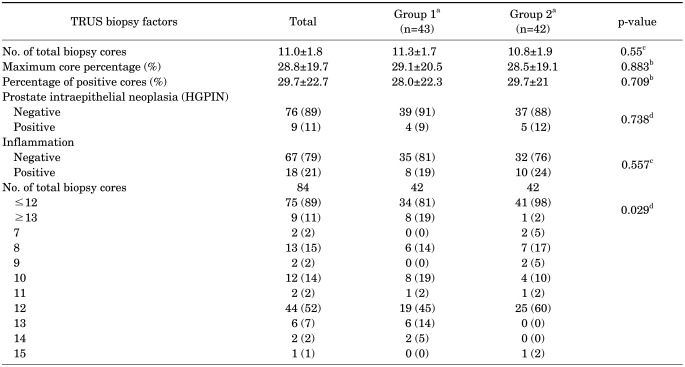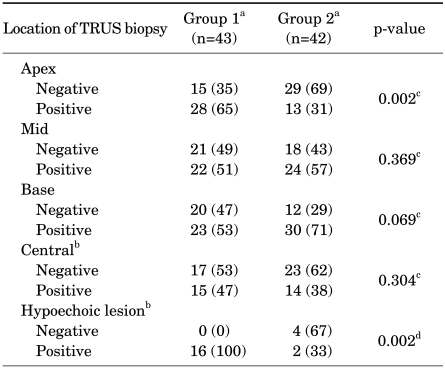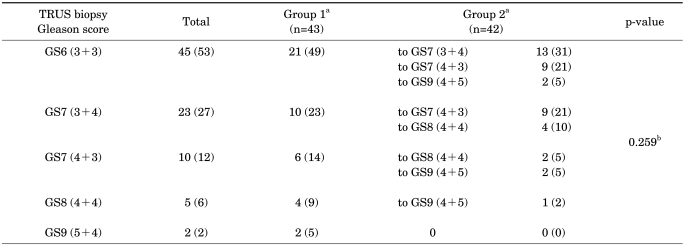1. Kim SC, Hong JH, Song K, Jeong IG, Song C, Kim CS, et al. Predictive factors for upgrading or upstaging in biopsy Gleason score 6 prostate cancer. Korean J Urol. 2009; 50:836–842.

2. Rubin MA, Bismar TA, Curtis S, Montie JE. Prostate needle biopsy reporting: how are the surgical members of the Society of Urologic Oncology using pathology reports to guide treatment of prostate cancer patients? Am J Surg Pathol. 2004; 28:946–952. PMID:
15223967.
3. Patel AR, Jones JS. Optimal biopsy strategies for the diagnosis and staging of prostate cancer. Curr Opin Urol. 2009; 19:232–237. PMID:
19365892.

4. Lim T, Park SC, Jeong YB, Kim HJ, Rim JS. Predictors of Gleason score upgrading after radical prostatectomy in low-risk prostate cancer. Korean J Urol. 2009; 50:1182–1187.

5. Miyake H, Kurahashi T, Takenaka A, Hara I, Fujisawa M. Improved accuracy for predicting the Gleason score of prostate cancer by increasing the number of transrectal biopsy cores. Urol Int. 2007; 79:302–306. PMID:
18025846.

6. Hong SK, Han BK, Lee ST, Kim SS, Min KE, Jeong SJ, et al. Prediction of Gleason score upgrading in low-risk prostate cancers diagnosed via mult (> or =12)-core prostate biopsy. World J Urol. 2009; 27:271–276. PMID:
19020885.
7. Dong F, Jones JS, Stephenson AJ, Magi-Galluzzi C, Reuther AM, Klein EA. Prostate cancer volume at biopsy predicts clinically significant upgrading. J Urol. 2008; 179:896–900. PMID:
18207180.

8. Kulkarni GS, Lockwood G, Evans A, Toi A, Trachtenberg J, Jewett MA, et al. Clinical predictors of Gleason score upgrading: implications for patients considering watchful waiting, active surveillance, or brachytherapy. Cancer. 2007; 109:2432–2438. PMID:
17497649.
9. Freedland SJ, Kane CJ, Amling CL, Aronson WJ, Terris MK, Prest JC Jr. Upgrading and downgrading of prostate needle biopsy specimens: risk factors and clinical implications. Urology. 2007; 69:495–499. PMID:
17382152.

10. Epstein JI, Walsh PC, Carmichael M, Brendler CB. Pathologic and clinical findings to predict tumor extent of nonpalpable (stage T1c) prostate cancer. JAMA. 1994; 271:368–374. PMID:
7506797.

11. Carter HB, Allaf ME, Partin AW. Wein AJ, Kavoussi LR, Norvick AC, Partin AW, Peters CA, editors. Diagnosis and staging of prostate cancer. Campbell-Walsh urology. 2007. 9th ed. Philadelphia: Saunders;p. 2912–2931.
12. D'Amico AV, Whittington R, Malkowicz SB, Schultz D, Blank K, Broderick GA, et al. Biochemical outcome after radical prostatectomy, external beam radiation therapy, or interstitial radiation therapy for clinically localized prostate cancer. JAMA. 1998; 280:969–974. PMID:
9749478.
13. Epstein JI, Partin AW, Sauvageot J, Walsh PC. Prediction of progression following radical prostatectomy. A multivariate analysis of 721 men with long-term follow-up. Am J Surg Pathol. 1996; 20:286–292. PMID:
8772781.
14. Moussa AS, Li J, Soriano M, Klein EA, Dong F, Jones JS. Prostate biopsy clinical and pathological variables that predict significant grading changes in patients with intermediate and high grade prostate cancer. BJU Int. 2009; 103:43–48. PMID:
18782303.

15. Montironi R, Mazzucchelli R, Scarpelli M, Lopez-Beltran A, Mikuz G, Algaba F, et al. Prostate carcinoma II: prognostic factors in prostate needle biopsies. BJU Int. 2006; 97:492–497. PMID:
16469014.

16. Nayyar R, Singh P, Gupta NP, Hemal AK, Dogra PN, Seth A, et al. Upgrading of Gleason socre on radical prostatectomy specimen compared to the pre-operative needle core biopsy: an Indian experience. Indian J Urol. 2010; 26:56–59. PMID:
20535286.
17. Tilki D, Schlenker B, John M, Buchner A, Stanislaus P, Gratzke C, et al. Clinical and pathological predictors of Gleason Sum upgrading in patients after radical prostatectomy: results from a single institution series. Urol Oncol. 2009; Epub ahead of print.
18. Turley RS, Hamilton RJ, Terris MK, Kane CJ, Aronson WJ, Presti JC Jr, et al. Small transrectal ultrasound volume predicts clinically significant Gleason score upgrading after radical prostatectomy: results from the SEARCH database. J Urol. 2008; 179:523–527. PMID:
18076952.

19. Kassouf W, Nakanishi H, Ochiai A, Babaian KN, Troncoso P, Babaian RJ. Effect of prostate volume on tumor grade in patients undergoing radical prostatectomy in the era of extended prostatic biopsies. J Urol. 2007; 178:111–114. PMID:
17499289.

20. Kahl P, Wolf S, Adam A, Heukamp LC, Ellinger J, Vorreuther R, et al. Saturation biopsy improves preoperative Gleason scoring of prostate cancer. Pathol Res Pract. 2009; 205:259–264. PMID:
19106019.

21. King CR, McNeal JE, Gill H, Presti JC Jr. Extended prostate biopsy scheme improves reliability of Gleason grading: implications for radiotherapy patients. Int J Radiat Oncol Biol Phys. 2004; 59:386–391. PMID:
15145152.

22. San Francisco IF, DeWolf WC, Rosen S, Upton M, Olumi AF. Extended prostate needle biopsy improves concordance of Gleason grading between prostate needle biopsy and radical prostatectomy. J Urol. 2003; 169:136–140. PMID:
12478121.

23. Takashima R, Egawa S, Kuwao S, Baba S. Anterior distribution of Stage T1c nonpalpable tumors in radical prostatectomy specimens. Urology. 2002; 59:692–697. PMID:
11992842.







 PDF
PDF ePub
ePub Citation
Citation Print
Print




 XML Download
XML Download